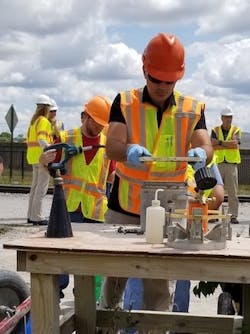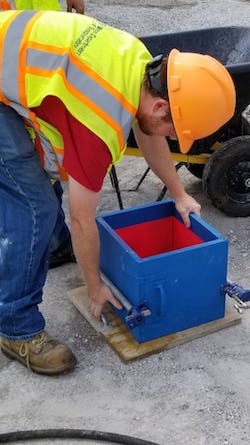How a performance engineered mixture program can create longer-life concrete pavements
Performance engineered mixtures (PEMs) have gained considerable attention recently in the concrete world.
National Concrete Pavement Technology Center (CP Tech Center) Director Peter Taylor is among a group of leaders spearheading a multi-year PEM program that is aimed at answering, according to Taylor, the question of “How can we write better specifications to get better concrete pavements? By making sure that the concrete mixture is appropriate for the environment, we can produce a pavement that will last as long as we want it to last.”
The five-year PEM program is a pooled-fund research program led by the Federal Highway Administration, as well as a number of strategic partners, including the CP Tech Center, several industry trade associations, a pair of universities, and a sizable run of state DOTs that includes Arkansas, California, Colorado, Georgia, Idaho, Illinois, Iowa (lead agency), Kansas, Michigan, Minnesota, New York, North Carolina, Ohio, Oklahoma, Pennsylvania, South Dakota, Tennessee, and Wisconsin. Industry sponsorship comes from the American Concrete Pavement Association (ACPA), the National Ready Mixed Concrete Association, the Portland Cement Association, and the Slag Cement Association.
The program involves evaluation of shadow projects in the 18 states currently participating in the program. The program also supports training field personnel, assisting contractors with review of their mixtures, and development of guidelines and tests that improve the development of durable concrete pavements.
The program’s ultimate goal is to move away from a local standardized approach to pavement mixture design specifications and to provide tools and resources that support customized specifications that reflect a region’s climate, the pavement’s anticipated environmental exposure, available materials, and expected lifespan. Incorporating a variety of parameters and customizing specifications gives an agency and its contractor an opportunity to innovate and produce cost-effective, long-lasting concrete pavements based on the unique needs and materials available in a project’s region or state.
“The PEM vision is to develop a better way of accepting concrete for paving,” ACPA President and CEO Gerald F. Voigt said. “This includes choosing parameters that matter more to pavement durability, finding tools to measure those parameters, including some new tests, and choosing appropriate test limits and protocols for applying the tests properly in terms of purpose, consistency, and repeatability. PEM is trying to improve the delivery of concrete pavements that lower the risk of premature material failures, while allowing for contractor innovation, adaptability for local conditions, and an appropriate level of inspection and testing.”
A focus on standards
Although the PEM program focuses on mixtures, it also considers quality programs and contractor construction practices, according to Voigt. Some important guidelines have been prepared, and a provisional standard—AASHTO PP84—has also been developed.
“Several states have been performing shadow testing using these guidelines, and significant efforts have been made on training for the test methods,” Voigt said, adding that ACPA chapters and members have been instrumental in the shadow testing—for example, the Wisconsin DOT is nearing the stage of developing a specification that would fully implement certain PEM test procedures.
Voigt said reports from the field indicate that “mixtures developed using PEM principles not only test out to be more durable, but also show improved smoothness behind the paver, require minimal finishing, and were deemed a value for slipforming both pavements and barrier walls.”
Emphasis on testing
The PEM program is underscoring both the importance of testing and the importance of considering new testing methods.
“Local specifications for concrete mixtures are prescriptive and do not consider differences in materials available in one part of the state versus another section, and do not consider climate,” Taylor said. Restrictive, one-size-fits-all specifications may not be robust enough to produce the right mixture needed to create a robust pavement in some areas.
The CP Tech Center has worked with a number of public agencies over the years to investigate the reasons for premature failure of pavements, said Gordon Smith, P.E., CP Tech Center Associate Director. “The problem is related to the durability of the concrete rather than the attributes typically tested for during mix design,” Smith said.
Tyler Ley, professor of structural engineering at Oklahoma State University, agreed with this view about the importance of testing and the need to consider testing methods that are outside the typical protocols used to test concrete, saying, “What you measure is managed. We’ve always measured slump, air content, and strength, but we’ve been measuring the same things for 30 years.”
Ley added that chemical admixtures and supplementary cementitious materials have made concrete mixtures more complex throughout this time, but observed that testing protocols and types of tests have not kept pace. “We’ve used the same slump test for almost 100 years,” he said, noting another test for specification compliance is the pressure meter, which became a standard in 1949.
The testing methods included in PP84—AASHTO’s provisional guide specification published in April 2017 and subsequently updated by the PEM Technical Advisory Committee—address parameters that control concrete mixture performance. They include fluid transport properties, strength, cold weather resistance, shrinkage, aggregate stability, and workability. There are two tests that provide critical information for PEM:
The Box Test is designed to test the workability of a concrete mixture for a slipformed pavement. Concrete is placed in a “box,” then concrete dimensions, vibrator frequency, head size, and time of vibration are adjusted to an energy comparable to a hydraulic vibrator on a paver. The sides of the box are removed to inspect surface voids and slumping to evaluate the mixture’s ability to hold an edge.
The Super Air Meter (SAM) functions in two ways. It provides all the same information as a conventional pressure meter but can also place the concrete under a series of higher pressures. By understanding how the concrete responds to the series of high pressures, the meter can assess properties of the air-void system beyond the air content. The result is a measurement that has been shown to correlate well with the spacing factor measurement and freeze-thaw performance data.
Permeability and reaction to climatic factors also play an important role in the durability of concrete, said Jason Weiss, Ph.D., head of the School of Civil and Construction Engineering at Oregon State University and director of the Kiewit Center for Infrastructure and Transportation Research. He described three types of tests that address permeability, reaction to deicing materials, and freeze-thaw durability for performance engineered concrete mixtures:
Resistivity Testing: Measuring the electrical resistivity of concrete yields an analog to measuring fluid transport in the concrete. This provides an indication of the permeability, water absorption, and diffusion coefficient of concrete. This is useful in assessing the water content and the durability of concrete mixtures.
Low Temperature Differential Scanning Calorimetry: Measuring the heat flow using differential scanning calorimetry provides an indicator of the potential for deleterious reactions with deicing salt. This provides an indication of mixtures that are more durable, especially at the longitudinal and transverse joints.
Matrix Saturation and Critical Saturation: Measuring the matrix and critical saturation provides an indicator of the freeze-thaw durability of concrete. These properties can be used in a service-life model for predicting the life of concrete pavements.
Because the PEM program is so dependent on testing to ensure quality durable pavements, the tests must be practical, said Ley. “Contractors spend more time testing the mixture before construction, and even though some tests might take more time, the results are worth the effort,” he said. For example, the SAM takes twice as long as a normal air test, but the extra five minutes might result in the development of a 50-year pavement versus a 40-year pavement, because adjustments to the mixture will be more precise.
A recent project on I-70 in Kansas DOT’s District 3 set specifications for total air content, permeability, strength, and thickness as part of the state’s PEM initiative. “We did adjust pay for strength and thickness as we always have, but we added pay adjustment for total air content and permeability on this project,” said Dave Meggers, P.E., bureau chief of research for KDOT. “We shadow-tested the SAM on this project, but did not adjust pay based on its results because we are still testing it to see how it correlates to traditional tests.”
The decision to participate in the PEM program and the FHWA transportation pooled fund was an easy one, said Meggers. “We’ve used optimized mixes in Kansas for the past 10-15 years, in an effort to reduce paste content and create more durable pavements,” he said. The opportunity to share ideas and learn from other researchers, contractors, and suppliers made sense as KDOT worked to improve performance of pavements.
Meggers remembered some apprehension from contractors when the agency first introduced the concept of optimized mixtures, but said that everyone now realizes the benefit of pre-qualifying the concrete mixture prior to construction. “We don’t tell them what mix design they must use, we just set the specifications they must meet,” he said. “For example, we don’t say they must use the Shilstone Method or the Tarantula Curve, we just say they must use an acceptable method to demonstrate that they’ve met the specifications, including final material properties.”
Although adopting a PEM strategy for specifications requires contractors and suppliers to work closely with agency representatives and to plan and test more diligently, Meggers sees the strategy as a win-win for agencies, contractors, and taxpayers. “When we all work together as partners to create the best pavement or concrete structure possible, we all benefit,” he explained. “Even contractors who were hesitant at first now report how much more consistent the mix is and how easy it is to work.”
What’s Ahead for PEM?
Looking to the second half of the pooled fund program, at a recent meeting in Minneapolis the FHWA Technical Advisory Committee (TAC) elevated its goal to move beyond shadow testing to begin full implementation, where a number of states’ standard construction contracts would require at least one of the PEM tests for mix qualification or acceptance.
“To reach the goal, the PEM implementation team will pursue writing a full guide specification and expand the training available on the tests. One of the key findings from shadow testing has been the importance of testing protocols,” Voigt said. “To move toward full implementation, the TAC concluded that ‘super trainers’ are needed to teach techniques to more technicians for execution in the field.”


